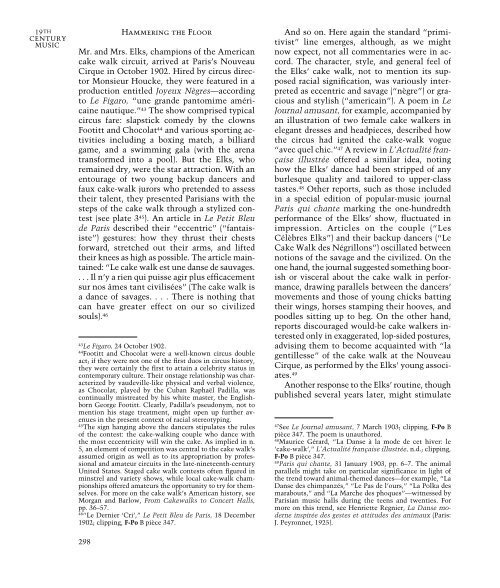Parisian Cake Walks.pdf - ResearchSpace@Auckland
Parisian Cake Walks.pdf - ResearchSpace@Auckland
Parisian Cake Walks.pdf - ResearchSpace@Auckland
Create successful ePaper yourself
Turn your PDF publications into a flip-book with our unique Google optimized e-Paper software.
19TH<br />
CENTURY<br />
MUSIC<br />
298<br />
Hammering the Floor<br />
Mr. and Mrs. Elks, champions of the American<br />
cake walk circuit, arrived at Paris’s Nouveau<br />
Cirque in October 1902. Hired by circus director<br />
Monsieur Houcke, they were featured in a<br />
production entitled Joyeux Nègres—according<br />
to Le Figaro, “une grande pantomime américaine<br />
nautique.” 43 The show comprised typical<br />
circus fare: slapstick comedy by the clowns<br />
Footitt and Chocolat 44 and various sporting activities<br />
including a boxing match, a billiard<br />
game, and a swimming gala (with the arena<br />
transformed into a pool). But the Elks, who<br />
remained dry, were the star attraction. With an<br />
entourage of two young backup dancers and<br />
faux cake-walk jurors who pretended to assess<br />
their talent, they presented <strong>Parisian</strong>s with the<br />
steps of the cake walk through a stylized contest<br />
(see plate 3 45 ). An article in Le Petit Bleu<br />
de Paris described their “eccentric” (“fantaisiste”)<br />
gestures: how they thrust their chests<br />
forward, stretched out their arms, and lifted<br />
their knees as high as possible. The article maintained:<br />
“Le cake walk est une danse de sauvages.<br />
. . . Il n’y a rien qui puisse agir plus efficacement<br />
sur nos âmes tant civilisées” (The cake walk is<br />
a dance of savages. . . . There is nothing that<br />
can have greater effect on our so civilized<br />
souls). 46<br />
43 Le Figaro, 24 October 1902.<br />
44 Footitt and Chocolat were a well-known circus double<br />
act; if they were not one of the first duos in circus history,<br />
they were certainly the first to attain a celebrity status in<br />
contemporary culture. Their onstage relationship was characterized<br />
by vaudeville-like physical and verbal violence,<br />
as Chocolat, played by the Cuban Raphaël Padilla, was<br />
continually mistreated by his white master, the Englishborn<br />
George Footitt. Clearly, Padilla’s pseudonym, not to<br />
mention his stage treatment, might open up further avenues<br />
in the present context of racial stereotyping.<br />
45 The sign hanging above the dancers stipulates the rules<br />
of the contest: the cake-walking couple who dance with<br />
the most eccentricity will win the cake. As implied in n.<br />
5, an element of competition was central to the cake walk’s<br />
assumed origin as well as to its appropriation by professional<br />
and amateur circuits in the late-nineteenth-century<br />
United States. Staged cake walk contests often figured in<br />
minstrel and variety shows, while local cake-walk championships<br />
offered amateurs the opportunity to try for themselves.<br />
For more on the cake walk’s American history, see<br />
Morgan and Barlow, From <strong>Cake</strong>walks to Concert Halls,<br />
pp. 36–57.<br />
46 “Le Dernier ‘Cri’,” Le Petit Bleu de Paris, 18 December<br />
1902; clipping, F-Po B pièce 347.<br />
And so on. Here again the standard “primitivist”<br />
line emerges, although, as we might<br />
now expect, not all commentaries were in accord.<br />
The character, style, and general feel of<br />
the Elks’ cake walk, not to mention its supposed<br />
racial signification, was variously interpreted<br />
as eccentric and savage (“nègre”) or gracious<br />
and stylish (“americain”). A poem in Le<br />
Journal amusant, for example, accompanied by<br />
an illustration of two female cake walkers in<br />
elegant dresses and headpieces, described how<br />
the circus had ignited the cake-walk vogue<br />
“avec quel chic.” 47 A review in L’Actualité française<br />
illustrée offered a similar idea, noting<br />
how the Elks’ dance had been stripped of any<br />
burlesque quality and tailored to upper-class<br />
tastes. 48 Other reports, such as those included<br />
in a special edition of popular-music journal<br />
Paris qui chante marking the one-hundredth<br />
performance of the Elks’ show, fluctuated in<br />
impression. Articles on the couple (“Les<br />
Célèbres Elks”) and their backup dancers (“Le<br />
<strong>Cake</strong> Walk des Négrillons”) oscillated between<br />
notions of the savage and the civilized. On the<br />
one hand, the journal suggested something boorish<br />
or visceral about the cake walk in performance,<br />
drawing parallels between the dancers’<br />
movements and those of young chicks batting<br />
their wings, horses stamping their hooves, and<br />
poodles sitting up to beg. On the other hand,<br />
reports discouraged would-be cake walkers interested<br />
only in exaggerated, lop-sided postures,<br />
advising them to become acquainted with “la<br />
gentillesse” of the cake walk at the Nouveau<br />
Cirque, as performed by the Elks’ young associates.<br />
49<br />
Another response to the Elks’ routine, though<br />
published several years later, might stimulate<br />
47 See Le Journal amusant, 7 March 1903; clipping, F-Po B<br />
pièce 347. The poem is unauthored.<br />
48 Maurice Gérard, “La Danse à la mode de cet hiver: le<br />
‘cake-walk’,” L’Actualité française illustrée, n.d.; clipping,<br />
F-Po B pièce 347.<br />
49 Paris qui chante, 31 January 1903, pp. 6–7. The animal<br />
parallels might take on particular significance in light of<br />
the trend toward animal-themed dances—for example, “La<br />
Danse des chimpanzés,” “Le Pas de l’ours,” “La Polka des<br />
marabouts,” and “La Marche des phoques”—witnessed by<br />
<strong>Parisian</strong> music halls during the teens and twenties. For<br />
more on this trend, see Henriette Regnier, La Danse moderne<br />
inspirée des gestes et attitudes des animaux (Paris:<br />
J. Peyronnet, 1925).















